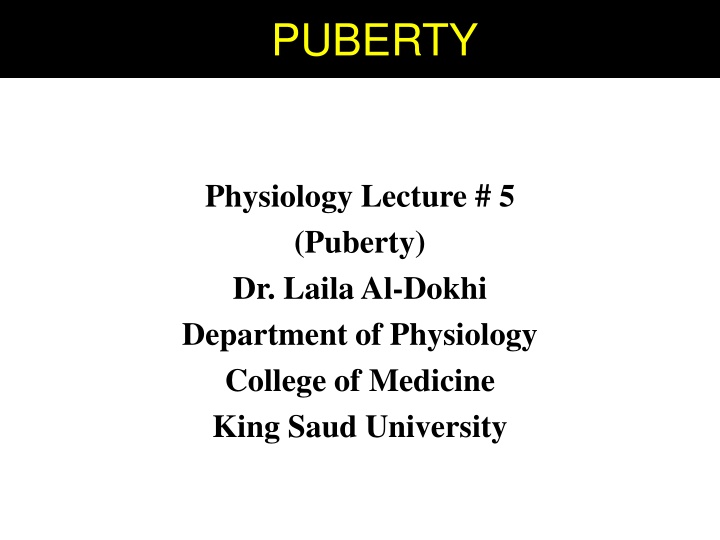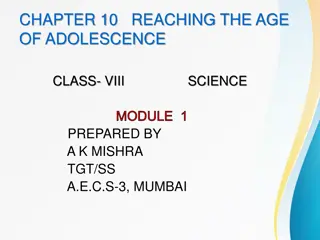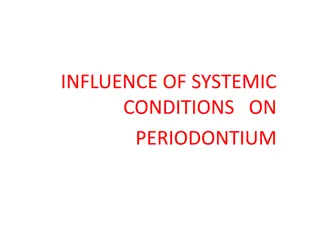
Puberty Process in Human Development
Explore the key aspects of puberty, including its definition, hormonal changes, staging of development, and associated terms and events like thelarche, pubarche, and menarche. Discover how puberty marks the completion of sexual maturation and growth, leading to the ability to reproduce in humans.
Download Presentation

Please find below an Image/Link to download the presentation.
The content on the website is provided AS IS for your information and personal use only. It may not be sold, licensed, or shared on other websites without obtaining consent from the author. If you encounter any issues during the download, it is possible that the publisher has removed the file from their server.
You are allowed to download the files provided on this website for personal or commercial use, subject to the condition that they are used lawfully. All files are the property of their respective owners.
The content on the website is provided AS IS for your information and personal use only. It may not be sold, licensed, or shared on other websites without obtaining consent from the author.
E N D
Presentation Transcript
PPUBERTY Physiology Lecture # 5 (Puberty) Dr. LailaAl-Dokhi Department of Physiology College of Medicine King Saud University
OBJECTIVES: 1. Definition of puberty. 2. Terms and events (thelarche, pubarche, menarche). 3. Hormonal changes ( gonadal and extra gonadl). 4. Female hormonal changes and male hormonal changes and secondary sexual characters. 5. Staging of pubertal development (tanner) in boys and girls. 6. Pubertal disorders ( precocious puberty and delayed puberty).
PUBERTY A stage of human development when sexual maturation and growth are completed and result in ability to reproduce. Accelerated somatic growth Maturation of primary sexual characteristics (gonads and genitals) Appearance of secondary sexual characteristics (pubic and axillary hair, female breast development, male voice changes,...) Menstruation and spermatogenesis begin
Puberty Terms & Events Thelarche: development of breast Puberache: development of axillary & pubic hair Menarche: the first menstrual period Adrenarche: the onset of an increase in the secretion of androgens, responsible for development of pubic and axillary hair, body odour and acne.
Puberty hormonal changes Hormonal changes procede physical changes Increased stimulation of hypothalamo-pituitary- gonadal axis gradual activation of the GnRH (LHRH) increases frequency and amplitude of LH pulses. gonadotropins stimulate secretion of sexual steroids (estrogenes and androgenes) extragonadal hormonal changes (elevation of IGF-I, and adrenal steroids)
Hypothalamic-Pituitary-Gonadal Axis hypothalamus GnRH Steroidal & Non-steroidal hormones pituitary FSH/LH ovary
Puberty hormonal changes Puberty: Nocturnal GnRH pulsatility (LH secretion) precedes phenotypic changes by several years First phenotypic changes: breast development / testicular enlargement
Puberty hormonal changes in young children, LH and FSH levels insufficient to initiate gonadal function between 9-12 yrs., blood levels of LH, FSH increase. Hormonal changes precede physical changes. amplitude of pulses increases, especially during sleep high levels of LH, FSH initiate gonadal development
Puberty hormonal changes GH secretion from pituitary also increases TSH (thyroid stimulating hormone) secretion from pituitary increases in both sexes: increases metabolic rate promotes tissue growth
Puberty Female hormonal changes surge of LH release initiates 1st ovarian cycle usually not sufficient to cause ovulation during 1st cycle brain and endocrine systems mature soon thereafter estrogen levels in blood increase, due to growing follicles
Physical Changes 5 stages from childhood to full maturity Marshall and Tanner (P1 P5) Reflect progression in changes o;f the external genitalia and of sexual hair Secondary sexual characteristics Mean age 10.5yrs in girls Mean age 11.5 12yrs in boys
Puberty Female hormonal changes estrogen induces secondary sex characteristics: growth of pelvis deposit of subcutaneous fat growth of internal reprod. organs, external genitalia androgen release by adrenal glands increases (not as much as in male) growth of pubic hair, lowering of voice, growth of bone, increased secretion from sebaceous glands.
Staging of pubertal development (Tanner) Pubertal development is classified according to the Tanner standard 5 different stages Girls: breast (B1-5), pubic hair (Pu1-5), axillary hair (A1-5), menarche Boys: testicular volume > 4 ml (Te), penis enlargement (G1-5), pubic hair (Pu1-5), axillary hair (A1-5), spermarche Monitoring of the pubertal growth acceleration growth velocity is 2-3 times greater than prepubertal sexual dimorfism in pubertal growth
Puberty: Girls Breast enlargement usually first sign. Thelarche Menarche usually 2-3 yrs after breast development Growth spurt peaks before menarche Pubic and axillary hair growth: sign of adrenal androgen secretion Starts at similar stage of apocrine gland sweat production and associated with adult body odour
Pubertal Stages (Tanner) Female P1 Prepubertal P2 Early development of subareolar breast bud +/- small amounts of pubic and axillary hair P3 Increase in size of palpable breast tissue and areolae, increased pubic/axillary hair P4 Breast tissue and areolae protrude above breast Further increased pubic/axillary hair growth level. P5 Mature adult breast. Complete pubic/axillary hair growth
Puberty Male hormonal changes LH and FSH release increases ~10 yrs. of age spermatogenesis; androgen secretion adrenals also secrete androgens androgens initiate growth of sex accessory structures (e.g. prostate), male secondary sex characteristics (facial hair, growth of larynx)
Puberty Male hormonal changes androgens causes retention of minerals in body to support bone and muscle growth Sertoli cells also secrete some estrogen
Puberty: Boys First signs often go unnoticed Testicular enlargement (12-13 yrs) Prepubertal testis 2mls diameter Puberty begins when volume reaches 4mls Penile and scrotal enlargement occur approx 1 yr after testicular enlargement. Pubic hair appears at same time Begins of spermatogenesis; androgen secretion
Pubertal Stages (Tanner) Male P1 Prepubertal, testicular volume < 2mls P2 Enlargement of scrotum and penis. Scrotum slightly pigmented. Few pubic hairs P3 Lenghtening of penis. Further growth of testes and scrotum. Pubic hair darker P4 Penis increases in length and thickness. Increased pigmentation of scrotum. Incresed pubic/ axillary hair P5 Genitalia adult in size and shape. Completed pubic/axillary hair growth
Sleep dependent nocturnal rise in LH
Puberty hormonal changes HYPOTHALAMUS GnRH AND GHRH PITUITARY GROWTH HORMONE LH & FSH LIVER OVARY IGF-1 SEX STEROID SYNTHESIS SEXUALMATURATION SOMATIC GROWTH
Normal pubertal development Boys Girls Age of start (yrs) First sign of puberty 12,5 (10 - 14) G2 (testicular volume up to 4 ml) 10,3 (Tanner III-IV) 3,2 1,8 (adult size of testis ) 11,5 (9 - 13) B2 Growth velocity (cm/yr) Duration of puberty (yrs) 9,0 (Tanner II-III) 2,4 1,1 (menarch )
Timing of Puberty Genetics: 50-80% variation in pubertal timing. trend toward earlier puberty exists within Western Europe and USA examination of lifestyle changes may give clues regarding mechanisms inducing onset one of the contributing factors: nutrition
Nutrition Critical body weight must be attained before activation of the reproductive system . even though age of menarche is decreasing, the average body weight of menarche remains the same earlier puberty due to improvement of nutrition, living conditions, healthcare? evidence supporting hypothesis: obese girls go through early menarche malnutrition is associated with delayed menarche primary amenorrhea common in lean female athletes bodyfat setpoint very noticeable in girls with fluctuating body weight due to anorexia nervosa
Potential involvement of Leptin: Leptin hypothalamus NPY GnRH symp. n.s. insulin glucocorticoids food intake thermogenesis reproduction Adipocyte (fat cell)
Pubertal disorders A. Precoccious puberty B. Delayed puberty
PRECOCIOUS PUBERTY Precocious onset of puberty is defined as occurring younger than 2 SD before the average age Girls <8 years old Boys <9 years old More common in females. Uncommon in males (usually pathological). Maybe associated with a growth spurt. 1. Gonadotrophin-dependent (true / central ) 2. Gonadotrophin-independent
Gonadotrophin-dependent precocious puberty (true / central ) Intra-cranial lesions (tumours, hydrocephalus, CNS malformations Gonadotrophin secreting tumours v. rare
Gonadotrophin-independent precocious puberty Precocious pseudopuberty No spermatogenesis or ovarian development FSH & LH suppressed Congenital adrenal hyperplasia (CAH) Sex steroid secereting tumours adrenal or ovarian
Delayed puberty - definition Initial physical changes of puberty are not present by age 13 years in girls (or primary amenorrhea at 15.5-16y) by age 14 years in boys Pubertal development is inappropriate the interval between first signs of puberty and menarche in girls/completion genital growth in boys is > 5 years
Causes of delayed puberty Gonadal failure (Hypergonadotrophic hypogonadism) Turner s Syndrome Post-malignancy chemo / radiotherapy / surgery Polyglandular autoimmune syndromes Gonadal deficiency Congenital hypogonadotrophic hypogonadism (+anosmia) Hypothalamic/pituitary lesions (tumours, post-radiotherapy) Rare gene mutations inactivating FSH/LH or their receptors
Turner syndrome Turner syndrome Karyotype 45,X (45,X/46,XX, structural abnormalities of X chromosome) Short stature (final height 144-146 cm) Gonadal dysgenesis Skletal abnormalities Cardiac and kidney malformation Dysmorfic face No mental defect Impairment of cognitive function) Therapy: growth hormone, sex hormone substitution H. Tuner, 1938






















